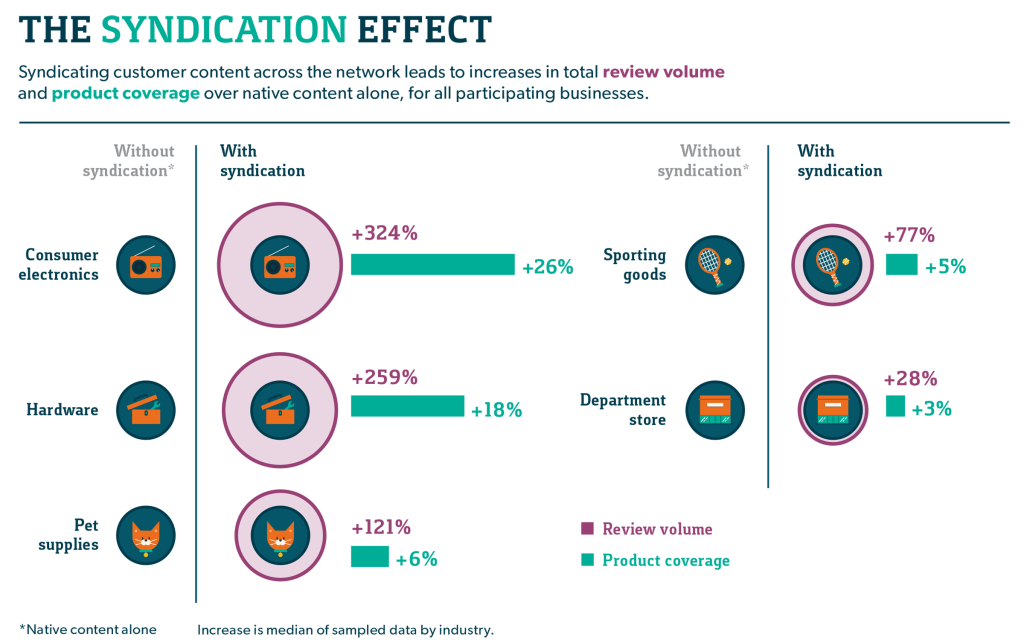January 13, 2015
The internet is evolving even faster than we imagined—and in ways many of its earliest pioneers never predicted. This is especially true for businesses and consumers in the online marketplace. The driving force of this evolution is user-generated content (UGC), such as product reviews, photos and videos.
In the eighth edition of The Conversation Index, we explore how sharing UGC across networks (such as Bazaarvoice) and channels improves sales, insights, and search results traffic—and why there’s no such thing as too much UGC.
For our time-stretched blog readers (we know you’re still catching up from the holidays), this post presents a condensed version the first half of The Conversation Index’s key points. A future blog post will highlight the second half.
Syndication increases the volume (and impact) of content across the network
Sharing UGC across different networks, also known as syndication, increases content volume. Across the Bazaarvoice network, businesses syndicate UGC to vendor or channel partner sites. This includes reviews and Q&A, as well as consumer-created photos and videos. The same UGC displaying on your website and a partners website is still beneficial, as long as the content is seen.
Take review photos as an example. Our eye-tracking study found that 25 online shoppers looked at product images first, before any other product page content. UGC syndication also means more conversation. In the hardware industry, we found that syndication accounted for a 259% increase in total content over native content. That resulted in an 18% increase in product coverage.
But why does this increase in content volume matter?
Increased UGC boosts conversion rates
Online reviews are one of the most powerful forms of UGC. Here are some stats we found from our network:
- Adding a single review to a product page increases orders by 10%
- 30 reviews increases orders by 25%
- 100 reviews increases orders by 37%
Analysis of review data across thousands of products and multiple product categories shows continued incremental revenue opportunity beyond 500 and 1000 reviews per product. Simply put, increased UGC volume means more shoppers seeing reviews and increased buyers confidence. This translates into higher revenue for businesses.
Dynamic content improves search traffic and rankings
Search engines reward websites with fresh, unique content with higher search results. Because online reviews offer a consistent stream of content about your products and services, they can significantly improve your search results ranking.
Each new review acts as a social trigger to search engines, improving the product or service’s reputation score. Search engines also detect the date that each new review is published, improving the site’s freshness score when new content is discovered.
Higher UGC volume improves product insights
The more reviews a business receives, the more benefits. In fact, once a business receives more than 100 reviews, they gain an incredibly valuable understanding of customer insights towards their business.
But how do businesses analyze these insights? One method is moderation with content tagging. Moderators tag reviews that contain product suggestions or flaws and route them to the appropriate parts of the business. Favorable reviews are usually the most valuable for insights, with three and four star reviews being more than twice as likely to contain product suggestions.
Reviews are also helpful for buyers. Reviews containing product suggestions and flaws are 2.5 times more likely to receive positive helpfulness votes from other shoppers. Five-star reviews provide value, with 18% receiving positive helpfulness votes.
The bottom line: UGC brings huge benefits
When a customer writes a review, posts a review photo, or records a video review, they’re benefitting businesses and customers alike. Businesses gain tremendous benefits from higher sales conversions, improved search engine result placement and customer insights. Customers gain purchasing confidence they lacked in the pre-internet era.
There’s much more in the full Conversation Index, and the infographic below gives a nice overview of some of the findings:








